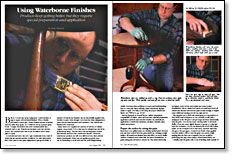Using Waterborne Finishes
Products keep getting better, but they require special preparation and application
Synopsis: Andy Charron, author of a book on spray finishing, figured out a way to apply even coats of waterborne lacquers that are smooth and free of defects, whether using sprayers or pads and brushes. In this article, he explains the less obvious ways waterborne finishes differ from solvent-based finishes. Then he explains how to apply them, starting with preparing the surface, ensuring that the finishing products are compatible, and then thoroughly mixing and straining the finishing materials. He covers spray and brush application methods and talks about how weather conditions will affect the finish.
Before I owned any spray equipment, I used brushes or rags to apply solvent-based finishes. When I finally purchased a spray gun, I had a limited amount of money and very little shop space, so I could not set up a proper spray booth. I sought out finishes that were nonflammable and relatively safe to use. Waterborne lacquers were the obvious choice. All I needed was a fan for air circulation and a clean place to spray.
It took trial and error, but now I get consistently even coats of finish that are smooth and free of defects. I’ve also discovered that I don’t have to use spray equipment to get good results. A number of waterborne finishes can be successfully applied with brushes or pads. Even though I now have the shop equipment to spray solvent-based lacquers and varnishes, I use waterborne finishes 90% of the time.
Many states now regulate the amount of solvent or volatile organic compounds (VOCs) that may be released into the air by professional shops. This has led to the development of more user-friendly and less-toxic waterborne finishes. However, waterborne products are still very different from their solventbased counterparts. If they are not applied properly, they can be frustrating to work with and can yield disappointing results. Knowing what problems to expect and understanding how to overcome them will help make waterborne finishes easier to apply.
Success depends on several factors: surface preparation, compatibility of sealers, stains and topcoats, material preparation, application methods and even the weather. My methods are applicable to waterborne urethanes, lacquers, enamels, dyes, sealers and primers.
Prepare the surface by raising the grain
If you have ever spilled water on a freshly sanded piece of wood, you may have noticed how the grain stands up, creating a rough surface. All waterborne finishes have this effect on wood. Earlier versions contained more water than the newer formulations, so grain-raising isn’t as bad as it used to be. The resins used today are lighter, more viscous and require less water in their formulations. But no matter how much you sand bare wood, all waterborne finishes will raise the grain at least enough to require some additional sanding.
From Fine Woodworking #125
For the full article, download the PDF below:
Fine Woodworking Recommended Products

Odie's Oil

Festool DF 500 Q-Set Domino Joiner

Stanley Powerlock 16-ft. tape measure





















Log in or create an account to post a comment.
Sign up Log in